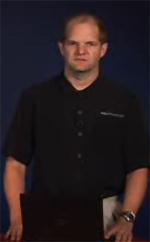Roy W. Stedman
The New York Times article Turning Point for Touch Screens said
“BREAKTHROUGHS often beget other breakthroughs, and Apple’s slick use of touch technology on its iPhone has set touch-screen makers to salivating. An industry once relegated to niches now sees the potential for riches.‘We don’t use fingerpaint on our desks to write notes,’ says Roy Stedman, a technology strategist at Dell. Mr. Stedman envisions things like using one finger to ‘hold’ a folder and another to flick e-mail messages into it, or adjusting the volume on a PC by ‘twisting’ a knob instead of mousing over it.
In the meantime, some specialized consumer applications are likely to adopt multitouch technology, like casino gambling and other games. Imagine moving checkers or Scrabble tiles on a screen with your fingers.
Such applications may help touch technology overcome a classic chicken-and-egg problem. ‘A lot of people don’t realize they want it until they use it,’ Mr. Stedman says.”
Roy W. Stedman is Technology Strategist for Dell Inc., having previously held software development roles in Software Technology, Digital Home integration, End User Software experience, and Ease of Use Development.
His current areas of research include intuitive touch and gesture-based interfaces, vision, and integrated connectivity use models. Previous research areas included intuitive software interfaces, reduced power consumption computing, and automated PC software self-repair.
He has presented at a number of industry conferences and interest groups, speaking on topics such as wireless data futures, multi-touch and gesture input direction and set public policies for reduced-power computing. He has been quoted and his work cited in a number of articles and publications.
Roy is an inventor of more than 25 US and international patents and applications and holds a BA from the University of Texas at Austin. He has focused on personal computing man-machine interfaces since the early days of the PC industry.
His patents include Enabling Instant Productivity Functionality on Information Handling Systems, Information handling system including standby/wakeup feature dependent on sensed conditions, System and Method for Adaptive Information Handling System Power Management, Method and system to dynamically boot to a non-visible partition, Virtual ring camera, Build-to-order embedded operating system partition, Method of remotely controlling power to an information handling system via a peripheral bus after a loss of power, Method and apparatus for capturing display characteristic information to achieve faster boot and resume of an information handling system, and System and method for optical media marking.
Read his LinkedIn profile.
